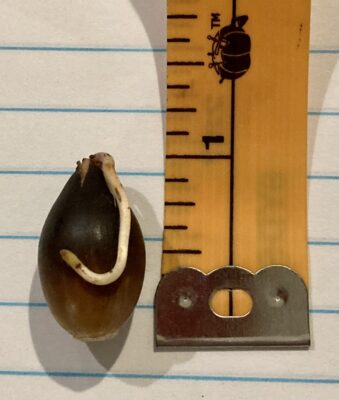
I’m hearing that folks are finding it difficult to be hopeful and thankful this Thanksgiving week.
The general mood is more dark than festive. Here’s a little story of hope that might help.
My brother is doing a science experiment at our house. More accurately, this experiment has taken up residence in the garage, in little planters under the bench on the front porch and even in the outside fridge. If you look at the photo, can you guess what it is? He is growing live oak trees from acorns! Pictured is a sprouted acorn from the huge, beautiful and historic live oak in the parking lot of the businesses between Eighth and Ninth streets on Ash Street. If you have lived here awhile, you will recognize that address as the former Fred’s.
The experiment started when my brother noticed an enormous number of acorns on the pavement under that tree. He thought, “This is a waste. They will just be crushed by cars.” He did a little research and learned that these trees do what is called “masting,” which means they release tons of acorns at once to ensure their propagation. They release more than acorn predators, like squirrels and blue jays, can steal and eat. Since these acorns were falling on pavement, not fertile soil, he thought they could use his help. He found out the best time to pick them up is right after they have fallen to the ground. Armed with bags for collection, he hopped on his scooter in the early morning to pick up some.
You can tell if an acorn is viable if you put it in water and it sinks. The ones that float don’t have enough good stuff inside. He gathered some acorns from other locations too. At this phase of the experiment, we had bowls and jars of floating and sinking acorns around the kitchen. He labeled the collection bags. Almost every single acorn from the tree by the former Fred’s was viable. He kept the acorns slightly moist until he was ready to plant them. He started them in little biodegradable pots. Two acorns were put in each pot, just in case. Now we wait to see what’s next. He learned that you can plant them outdoors in late fall. They will develop their roots in the darker colder weather. Here is the first glimmer of hope. Dark times can be fruitful. Turning inward can stimulate growth. We can pause and ponder.
If you purchase a more mature tree, roots have to be cut to make a ball to transport it. That tree will take time to reestablish a root system before it can expend energy growing upward and outward. The tree grown from the acorn will be more stable and will have a healthier root system that grows proportionately. Here is another image of hope. Starting small is not a disadvantage. All you have to do is look at the tree in that parking lot to see that.
The acorn and its sprout in my photo measure only one inch. Here is my suggestion for your own hopeful experiment. Go to that parking lot and look up into the magnificence of that tree. You might even try to spread your arms around its enormous trunk. Children do it all the time.
Ponder how this tree started as a one-inch long acorn with a tiny shoot emerging from it, growing through dark and stormy times, watching history unfold beneath its branches. I have heard it said that hope can be defined simply as realizing that what is, is not permanent. Change happens all around us all the time. Be present to this moment and take notice of its small but mighty gifts.
Jesus of Nazareth told many stories about growth and change and hope. He used images from everyday life. As recorded in Mark’s gospel, Jesus said, “How can I describe the realm of God? What story should I use to illustrate it? It is like a mustard seed planted in the ground. It is the smallest of all seeds, but it becomes the largest of all garden plants; it grows long branches, and birds can make nests in its shade.” (Mark 4: 30-32)
May you have an acorn and mustard seed type of Thanksgiving.

We have Mary Agnes Wolff White to thank for saving Fred’s tree, a Fernandina Heritage tree. If not for her alerting the community that Winn Dixie planned to destroy the tree in preparation for opening a new store, it would be gone. Even back in the 1950’s we had citizens trying to preserve our beautiful trees.
Thanks, Lyn. I am glad to know who saved it.
What a beautiful way to continue the legacy of such a majestic tree! Sadly, there are more people willing to allow these magnificent trees to fall to the ground with a chainsaw than there are who want to see them stand tall for another 50 years. The policymakers in our capital have chosen to let developers have the power over the citizens so now we no longer have the ability to do much of anything when their bulldozers come. It’s beyond maddening, but if you have a piece of property, YOU can start NOW by planting a tree for the future generations.
What a lovley experiment and homily to share. Thank you! For all the information as well.
Great class room science project too!
Now, where to plant them all?!
Love this! What a great idea!
I love this story! So uplifting! We need more people like your brother….and you! What great family genes you have – such wise words, and actions that demonstrate compassion and caring, and looking outward to see how you can have a positive impact on the world!